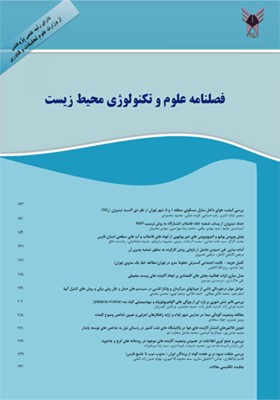برگشت مجدد پساب پالایش شده فرایند تولید زانتان به دور جدیدتخمیر
محورهای موضوعی : مدیریت محیط زیست
سمانه صدیقی خویدک
1
*
,
محمدرضا صعودی
2
,
جمشید فولادی
3
![]()
1 -
2 -
3 -
کلید واژه: پسماند تخمیر, زانتان, فیلتر C18, برگشت مجدد, Xanthomonas campestris,
چکیده مقاله :
با توسعه بیوتکنولوژی و فرایندهای تخمیری در ایران اهمیت پالایش این نوع پساب ها و توجه به آن ها افزون تر شده است. یکی از روش های کاهش پساب های تخمیری، برگشت (Backsetting) و مصرف مجدد پساب در دور جدید تخمیر می باشد که در این تحقیق جهت کاهش حجم پساب فرایند تخمیری تولید زانتان و همچنین کاهش مصرف آب مورد استفاده قرار گرفته است. در این پژوهش ابتدا ویژگی های اصلی پسماند حاصل از تخمیر زانتان، به لحاظ شیمیایی و میکروبی تعیین شد. سپس پسماند تخمیر به کشت های جدید در غلظت ها و زمان های مختلف افزوده شد و اثرات فرایند فوق بر کمیت و کیفیت تولید محصول بررسی گردید. نتایج نشان داد که استفاده از روش های مختلف فیزیکوشیمیایی برای فرآوری پسماند، قبل از برگشت دادن آن به دور جدید تخمیر لازم است که در این تحقیق، اثر پسماند پالایش شده با فیلتر C18 بررسی شد. بررسی فراتر مشخص کرد که مصرف پسماند تیمار شده با فیلتر C18 در تراکم 25% حجمی، در محیط کشت تولید زانتان موجب تولید g/L 91/11محصول خام شد در حالی که در محیط کشت کنترل مثبت (محیط تولید بدون پسماند)،g/L 68/11محصول خام تولید شد. همچنین افزایش 107% محصول خام، 70% زانتان خالص و 67% ویسکوزیته نسبت به کنترل منفی (محیط تولید که در آن از پسماند تیمار نشده، استفاده می شود) مشاهده شد.
Parallel to development of biotechnology and fermentation processes in the country, the importance of the wastewater treatment has been increased. One of the cost effective methods in fermentation and wastewater treatment is back setting and recycling wastewater in a new run of fermentation which is used in this project to reduce xanthenes fermentation wastewater and water usage. In this project, the main chemical and microbiological characteristics of distilled wastewater were determined. Thereafter distilling was added to new batches of fermentation in different concentrations at different times; and the effect of these additions on xanthenes production quality and quantity were examined. This study showed that the use of different physic – chemical methods is necessary for the distilling treatment before its back setting in a new fermentation batch. For this purpose, in this project, the effect of treated distilling with C18 disk was examined. Further examinations showed that the back setting of distilling treated with C18 disk in 25% concentration in Xanthenes production medium leads to producing of 11.91 g/l crude Xanthenes in comparison with the positive control (culture medium prepared from tap water), 11.68 g/l crude Xanthenes, was produced. Moreover, the increase of 107% crude xanthenes, 75% pure xanthenes and 67% viscosity compared to the negative control (culture medium prepared from raw distillation) is observed.

